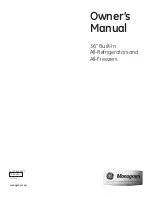
Freezer compartment
en
25
Food that is unsuitable for freezing
¡
Types of vegetables that are usu-
ally eaten raw, e.g. lettuce or
radishes
¡
Unpeeled or hard-boiled eggs
¡
Grapes
¡
Whole apples, pears and peaches
¡
Yoghurt, soured milk, sour cream,
crème fraîche and mayonnaise
Packing frozen food
If you select suitable packaging ma-
terial the correct type of packaging,
you can determine the product qual-
ity and prevent freezer burn.
1.
Place the food in the packaging.
Suitable packaging:
– Plastic film made of polyethyl-
ene
– Tubular film made of polyethyl-
ene
– Freezer bags made from poly-
ethylene
– Freezer containers
Unsuitable packaging:
– Wrapping paper
– Greaseproof paper
– Cellophane
– Aluminium foil
– Rubbish bags and used shop-
ping bags
2.
Squeeze out the air.
3.
Pack food airtight to prevent it
from losing flavour and drying out.
Suitable seals:
– Rubber bands
– Plastic clips
– Cold-resistant adhesive tape
4.
Label the packaging with the con-
tents and the date of freezing.
Shelf life of frozen food at
−18 °C
Observe the storage times when you
freeze food.
Food
Storage time
Fish, sausages, prepared
meals and baked goods
Up to 6 months
Poultry, meat
Up to 8 months
Vegetables, fruit
Up to 12 months
Defrosting methods for frozen
food
To retain the best-possible product
quality, the defrosting method must
be adjusted to the food and applica-
tion.
CAUTION
Risk of harm to health!
During the thawing process, bacteria
may multiply and spoil the frozen
food.
▶
Do not refreeze food after it has
been defrosted or started to de-
frost.
▶
Refreeze food only after cooking.
▶
These items should no longer be
stored for the maximum storage
period.
Defrosting
method
Food
Refrigerator com-
partment
Animal-based food such
as fish, meat, cheese,
quark
Room temperature Bread
Microwave
Food for immediate con-
sumption or immediate
preparation
Oven or cooker
Food for immediate con-
sumption or immediate
preparation
















































